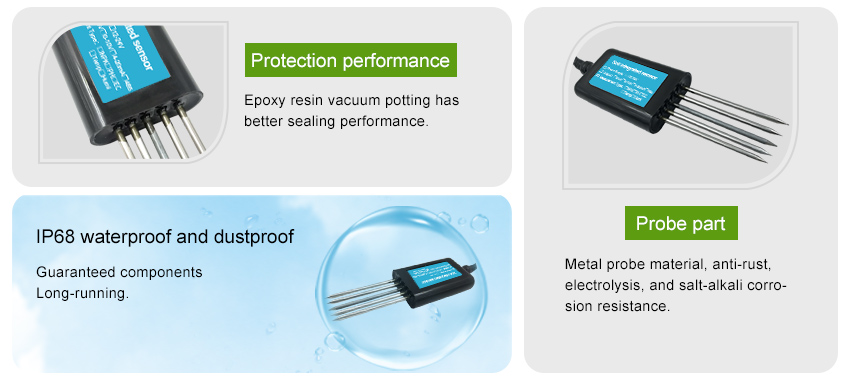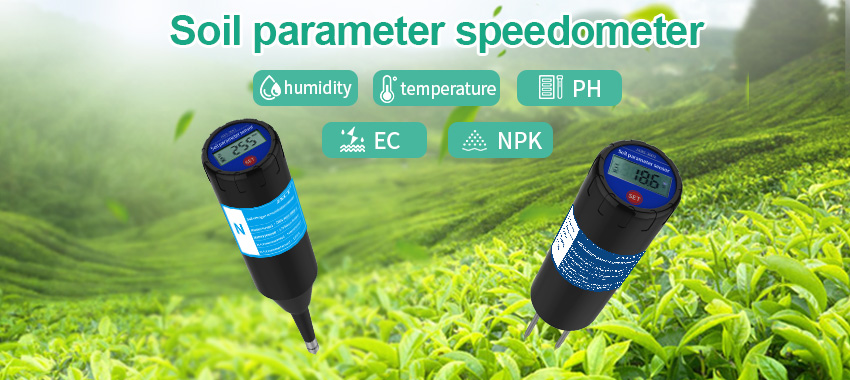background:
The soil temperature and humidity sensor consists of two sensors, a soil humidity sensor and a soil temperature sensor. It is related to the growth of crops and is the basis of farmland operations. A soil temperature sensor is a soil temperature sensor that can monitor the temperature of soil, atmosphere and water for experiments and scientific research. Soil temperature is closely related to the growth and development of crops, the decomposition of fertilizers and the accumulation of organic matter, and is an important environmental factor in agricultural production.
Soil temperature is also an extremely important factor in the formation of microclimate. Therefore, the measurement and research of soil temperature is an important content in microclimate observation and agricultural meteorological observation. Soil moisture sensor is also known as: soil moisture sensor, soil moisture sensor, soil moisture sensor. Mainly used to measure soil volume water content, do soil moisture monitoring and agricultural irrigation and forestry protection.
Soil Moisture Sensor Classification:
After more than half a century of development, soil moisture sensors have come in many varieties and forms. The measurement of humidity has a certain complexity, and the well-known hair hygrometer, wet and dry bulb hygrometer, etc. can no longer meet the actual needs of modern requirements. Therefore, various soil moisture sensors have been developed. Humidity sensors can be generally divided into capacitive type, resistance type, ion sensitive type, light intensity type, surface acoustic wave type, etc.
Capacitive Soil Moisture Sensor:
The sensitive element of the capacitive soil moisture sensor is a humidity sensitive capacitor. The main materials are generally metal oxides and high molecular polymers. These materials have strong adsorption capacity for water molecules, and the amount of adsorbed water varies with the change of ambient humidity. Due to the large electric dipole moment of water molecules, the permittivity of the material changes after water absorption, and the capacitance value of the capacitor also changes. The change of capacitance value is converted into an electrical signal, and humidity can be monitored.
Moisture sensitive capacitors are generally made of polymer film capacitors. When the ambient humidity changes, the dielectric constant of the humidity sensitive capacitor changes. Its capacitance also changes, and its capacitance change is proportional to relative humidity. Using this feature, humidity can be measured. Commonly used capacitive soil moisture sensing media are: porous silicon, polyimide, in addition to polysulfone (PSF), polystyrene (PS), PMMA (linear, cross-linked, plasma polymerization).
Resistive Soil Moisture Sensor:
The sensitive element of the resistance type soil moisture sensor is a humidity sensitive resistor, and its main materials are generally dielectrics, semiconductors, porous ceramics, etc. These materials have strong adsorption of water, and the resistivity/conductivity will change with the change of humidity after adsorption of water. In this way, the change of humidity can lead to the change of the resistance value of the humidity sensitive resistor, and the change of the resistance value can be converted into the required electrical signal. For example, an aqueous solution of lithium chloride forms a thin film on the substrate. As the water vapor content in the air increases or decreases, the film absorbs moisture and dehumidifies.
The concentration of salt in the solution decreases and increases, the resistivity increases and decreases, and the resistance between the two stages increases and decreases. Another example is the porous ceramic humidity sensitive resistor, the ceramic itself is composed of many small crystal particles. Most of the pores are connected to the outside world, and water molecules can be adsorbed through the pores. Causes a change in ion concentration, which results in a change in resistance between the electrodes.
Ionic Soil Moisture Sensor:
Ion-sensitive field-effect transistors (ISFETs) belong to semiconductor biosensors, which were developed in the 1970s by P. Invented by Bergeld. The ISFET directly contacts the ion buffer solution in the measured solution through different sensitive thin film materials on the gate, and then the ion concentration in the solution can be measured. The ion-sensitive device consists of an ion-selective membrane (sensitive membrane) and a converter. The sensitive membrane is used to identify the type and concentration of ions, and the converter converts the information sensed by the sensitive membrane into electrical signals. Ion-sensitive field effect transistors make a layer of sensitive film on the insulating gate. Different sensitive membranes detect different ion species, so they have ion selectivity.

Introduction of Jingxun Unblocked Soil Temperature and Humidity Sensor:
The soil integrated sensor (5 in 1 soil sensor) is a soil integrated sensor independently developed by Jingxun Changtong Company. Soil temperature, soil moisture, soil pH, soil conductivity (EC), soil nitrogen (N ), phosphorus (P) and potassium (K) can be monitored simultaneously. The soil integrated sensor (5 in 1 soil sensor) adopts the international new generation TDR measurement method, and the detection accuracy can reach within 3%. The special metal probe greatly prolongs the service life of the product.The use of epoxy resin can be vacuum packed at high temperature, which can prevent moisture from entering the interior of the fuselage, and has better sealing performance. The probe is resistant to rust, electrolysis, and salt-alkali corrosion. Ensure that the probe part works for a long time. Suitable for all kinds of soil, low power consumption, high sensitivity and stable signal.

Soil Rapid Tester – Humidity, PH, NPK, EC, Temperature Detection:
The soil parameter rapid measuring instrument (soil sensor) has high precision. Soil sensors monitor soil temperature and humidity, pH, nitrogen, phosphorus, potassium and conductivity. Simple and convenient, low cost, fast measurement speed. After the metal probe is inserted into the soil, the measurement result can be displayed in a few seconds, and the measurement is accurate. The product is powered by 3.7V lithium battery, with low power consumption, long life and easy to use. The reading is clear, the high-definition large-screen display is convenient for reading, and the digital display is clear at a glance.